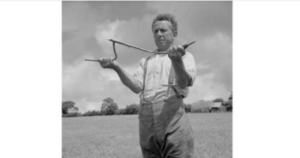In a world constantly evolving, we often find ourselves marveling at artifacts from the past, feeling like strangers in our own history. A recent online trend revolves around sharing images of mysterious objects, prompting a collective effort to identify their purpose and origin.
One such enigma making the rounds is an unassuming V-shaped tool resembling a tree branch. Despite its unremarkable appearance, this implement carries a rich history dating back to the 1500s, known by various names like “diviner,” “doodlebug,” “well witch,” or “water-finder.”

Primarily employed in a practice called “Water Dowsing,” this tool’s primary function is to locate water sources beneath the Earth’s surface. Describing the process, one expert explains, “An individual would hold both branches of the stick in each hand, palms facing upwards. The stem of the V is then tilted toward the Earth at a 45-degree angle. The user walks back and forth, searching for vibrations at the bottom of the V, indicating the presence of hidden water.”

This technique, initially used with metal rods to locate metals in the ground during the 1500s, transitioned into a method for finding water in rural areas for new homeowners. As times change, it’s these relics that bridge the gap between generations, offering a glimpse into the practices and tools that shaped our past.